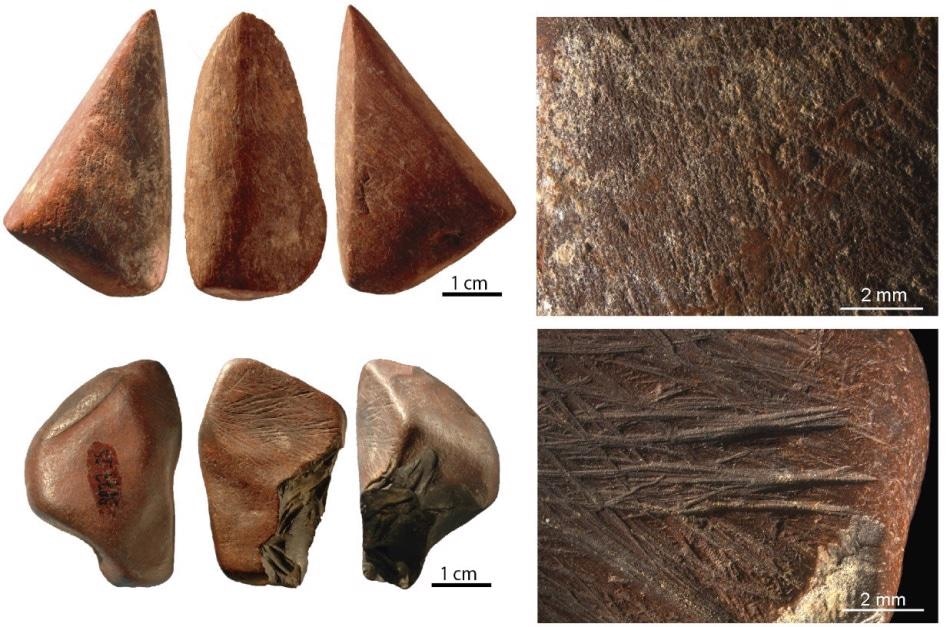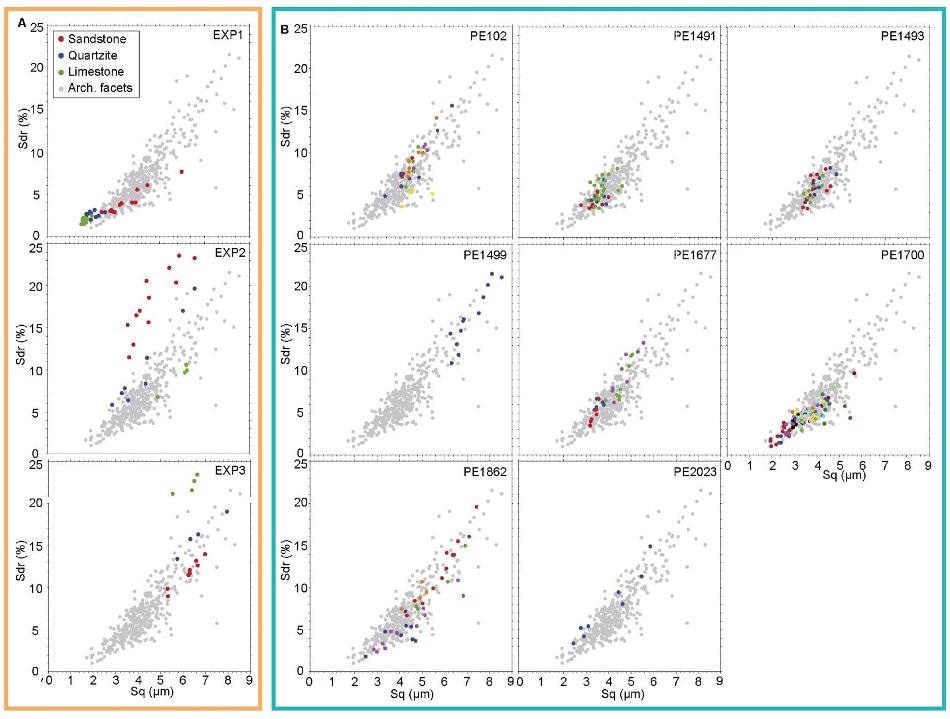In the case study discussed in this article, the objective of the study was to gain better insights into ochre use by Middle Stone Age populations in East Africa through the analysis of 4213 pieces of iron-rich mineral fragments (40 kg) discovered at the archaeological site of Porc-Epic Cave, Ethiopia, in layers dating back to ca. 40,000 years earlier (Rosso, d’Errico and Queffelec 2017).
The term “ochre” denotes a range of rocks characterized by a yellow or red streak or color, from soil lumps to ore minerals, comprising of iron oxides in high proportions. A vast range of ochre pieces excavated at this site exhibit traces of utilization, particularly striations and flaking scars developed by grinding. Twenty-one grindstones which were used for ochre processing were also unearthed at the site (Rosso, Pitarch Martí and d’Errico 2016) in the same regions where a majority of the ochre pieces were discovered (Rosso, d’Errico and Zilhão 2014). The aim of the tribological analysis, performed in accordance with more conventional analytical techniques, was to better perceive the way in which ochre pieces were processed and used.
The analyzed samples contained ochre pieces carrying facets developed by grinding (see Figure 1). Although these facets are frequently explained in the literature, no efforts have been taken to characterize them quantitatively. Experimental grinding of ochre lumps analogous to those present at the site on grindstones composed of various rocks enabled a comparative framework to be created. The variables widely used to characterize facets (size, presence of grooves or striations, localization on the fragment, and so on) were recorded and a non-destructive tribological analysis was performed using a 3D optical profiler.

Figure 1. Ochre fragments modified by grinding (top left) and by scraping (bottom left) with close-up views illustrating traces diagnostic of the technique used (modified after Rosso et al. 2017).
Measurements
The investigation was done on 19 archaeological pieces of fine-grained ochre expressing one or more facets, and three extremely fine-grained, fine-grained, and coarse-grained experimental ochre pieces. Each of them was scrapped on quartzite, limestone, and sandstone grindstones.
To cover vast areas, an area of 5 x 5 fields of view obtained with the 20x brightfield objective of Sensofar’s S neox with a Z-range of few millimeters was measured. Figure 2 illustrates some of the resulting surfaces, after data processing (form and outlier removal, filling of non-measured points).

Figure 2. 3D renderings of experimental (A, B, C) and archaeological (D to L) facets measured using confocal technique (modified after Rosso et al. 2017).
Gaussian filtering (0.25 mm cut-off ) was applied to concentrate only on roughness and, after checking multiple standard parameters (ISO 25178), Sdr and Sq seemed to be the most valuable option to distinguish between experimental facets (figure 3A). In certain cases, results underline major differences in the roughness values recorded on facets of the same ochre piece.
This implies that some ochre fragments were processed on different grindstones, possibly at different times, to yield small amounts of ochre powder. Granulometric and colorimetric analyses, carried out simultaneously, signify that the resulting powders varied in grain size and color and were used for various purposes, either functional or symbolic in nature (Rosso, d’Errico and Queffelec 2017).

Figure 3. Scatter plots correlating Sq and Sdr values on experimental and archaeological facets. (a) Results obtained when grinding very fine-grained ochre (EXP1), fine-grained ochre (EXP2), and coarse-grained ochre (EXP3) on grindstone made of different rocks. (b) Results of the roughness analysis of ground facets on archaeological pieces. Dots of the same color identify measurements taken on the same facet. Grey dots identify the overall variability of the archaeological sample (modified after Rosso et al. 2017).
Conclusions
Confocal technology is a valuable technique for the identification of facets of ochre pieces ground on different rocks. Results were helpful in enhancing the understanding of ochre processing and use by the Middle Stone Age hominins who colonized Porc-Epic Cave 4000 decades ago. By applying the same methodology to collections of ochre pieces from other Middle Stone Age sites, it may be possible to identify transformations over time in the way ochre was modified, to offer vital information on the function it executed in those societies, and to help determine when pigments were first used in a symbolic manner in the history of mankind.

This information has been sourced, reviewed and adapted from materials provided by Sensofar.
For more information on this source, please visit Sensofar Metrology.